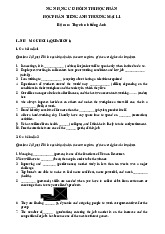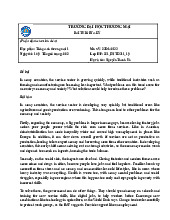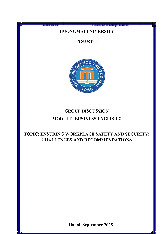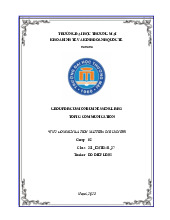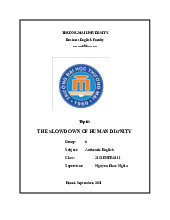














Preview text:
lOMoAR cPSD| 47207194
TRƯỜNG ĐẠI HỌC THƯƠNG MẠI
- ----------------***----------------- - LECTURE R
: Phạm Quang Trúc GROUP : 1 TOPIC
: Risk and opportunities in mergers and acquisition CLASS
: 241 _ENPR5121_03
Hanoi, March 2025 lOMoAR cPSD| 47207194 TASK ASSIGNMENT TABLE S T Name Student code Responsibility Comments T - Prepare essay content:
Strategies for Success in 1 Trần Minh An
23D170167 M&A, Game Question - Present - Do PowerPoint 2 Nguyễn Trâm Anh 23D170059 - Present - Prepare essay content:
Introduction, Opportunities 4 Phạm Ngọc Anh 23D170060 in M&A - Present - Prepare essay content: Risks of Merger and 5 Phạm Thị Minh Anh 23D170006 Acquisition - Present - Prepare essay content: Case Studies Trần Đức Anh 6 23D170061 - Present (Leader) - Edit essay content - Present 7 Trần Minh Anh 23D170062 - Do Word - Present - Do PowerPoint 8 Trần Ngọc Anh 23D170117 - Present Table of Content s 2 lOMoAR cPSD| 47207194
TASK ASSIGNMENT TABLE...................................................................................2
CONTENT............................................................................................................. 4
1.Introduction........................................................................................................4
1.1. Define Mergers and Acquisitions..........................................................................4
1.2. Importance of M&A in the Business World..........................................................4
2. Opportunities in M&A........................................................................................4 2.1 Economies of
Scale...............................................................................................4 2.2 Access to New
Markets........................................................................................4 2.3
Diversification of Product/Service
Offerings........................................................5 2.4
Superior Integration of Technology, Management, and Human Resources.........5 2.5 Competitive
Advantage........................................................................................5
3. Risks of Merger and Acquisition........................................................................5 3.1 Integration
Challenges..........................................................................................6 3.2 Cultural
Difference................................................................................................6 3.3 Department
Reorganization.................................................................................6 3.4 Financial
Risks.......................................................................................................7 3.5 Regulatory and Legal
Risk.....................................................................................7
4. Case Studies.......................................................................................................8 4.1 Successful M&A
Example.....................................................................................8 4.2 Failed M&A
Example............................................................................................8
5. Strategies for Success in M&A...........................................................................9 5.1 Thorough Due Diligence
......................................................................................9 5.2 Clear Integration
Plan.........................................................................................10 5.3. Strong
Leadership and Communication.............................................................10 3 lOMoAR cPSD| 47207194
5.4 Post-M&A Monitoring.........................................................................................11
6.Game Question.................................................................................................12
7.References……………………………………………………………………………………………………13 CONTENT 1. Introduction -
Watch a short video: Video 1.1.
Define Mergers and Acquisitions
Mergers: A merger is usually the combination of two businesses of about equal strength.
Acquisitions: is the purchase of one company by another—typically a bigger one buying a smaller one. 1.2.
Importance of M&A in the Business World
Mergers and Acquisitions (M&A) help determine a company’s value by assessing its
financial performance and market position. They also estimate future growth potential,
enabling businesses to make strategic investment decisions.
2. Opportunities in M&A
2.1 Economies of scale
Merging with or acquiring another company can result in cost savings and operational
efficiencies that would not be possible for either company alone. By merging resources,
businesses can reduce overhead costs, optimize production, and improve supply chain
management. Larger firms often have stronger bargaining power with suppliers, allowing
them to negotiate better prices for raw materials and services. Additionally, the integration
of technology and streamlined business processes helps eliminate redundancies and
enhance productivity. These advantages not only lead to lower per-unit costs but also
improve overall profitability and market competitiveness in the long run.
2.2. Access to new markets
Mergers and acquisitions (M&A) present a powerful opportunity for companies to access
new markets. By acquiring or merging with businesses that have an established presence
in different geographical regions or untapped customer segments, companies can bypass
the lengthy and costly process of building market presence from scratch. This strategy
enables businesses to leverage the acquired company's distribution networks, customer
base, and market knowledge, facilitating a smoother and faster entry. 4 lOMoAR cPSD| 47207194
Additionally, accessing new markets through M&A allows firms to mitigate risks
associated with market saturation in their home regions, ensuring sustained revenue
growth. For instance, a company based in North America acquiring a firm in Asia gains
immediate exposure to high-growth emerging markets, benefiting from local expertise and established relationships.
2.3. Diversification of product/service offerings
Another critical reason why M&A is essential in today's economy is that it provides
companies with the opportunity to diversify their businesses. Diversification is a strategy
that allows companies to reduce their risks by expanding their product or service offerings
across different markets. M&A allows companies to access new markets, customer
segments, and distribution channels that they may not have been able to reach
independently. For example, if a clothing manufacturer acquires a shoe manufacturer, the
buyer's clients will now buy shoes from them, while the existing clients of the shoe
company will also start buying clothes from them .
2.4. Superior integration of technology, management, and human resources
One of the most significant advantages of M&A is the superior integration of technology,
management expertise, and human resources. Through M&A, companies can gain access
to advanced technologies and innovative solutions that would otherwise take years and
substantial investments to develop internally. This immediate access enables businesses to
enhance their product offerings, streamline operations, and improve customer experiences.
In addition to technological advancements, M&A allows companies to leverage
management expertise from the acquired firm. Integrating experienced leaders and
specialized teams can strengthen strategic decision-making, optimize business processes,
and drive growth more effectively. The combined leadership can also facilitate the adoption
of best practices in areas such as marketing, finance, and supply chain management,
ensuring smoother integration and higher efficiency.
Moreover, M&A brings together diverse pools of talent, combining the skills, creativity,
and knowledge of employees from both organizations. This enriched human capital fosters
a culture of innovation and accelerates problem-solving capabilities. By uniting teams with
different backgrounds and perspectives, companies can generate fresh ideas, enhance R&D
capabilities, and respond more agilely to market demands. 2.5. Competitive advantage
Mergers and acquisitions can provide a competitive advantage by eliminating competitors.
When a company acquires a competitor, it not only removes a rival from the market but
also gains immediate access to the competitor’s customers, technologies, and distribution
channels. This strategic move can lead to a stronger market presence and increased pricing
power, allowing the acquiring company to set terms more favorably. 5 lOMoAR cPSD| 47207194
In addition to reducing competition, M&A helps companies neutralize competitive threats.
For example, acquiring a fast-growing competitor with disruptive technologies or
innovative business models prevents that rival from capturing significant market share in
the future. This approach allows the acquiring company to absorb and integrate innovative
capabilities instead of competing directly against them.
3.Risks of merger and acquisition
Mergers and acquisitions (M&A) can be a powerful tool for global business growth and
expansion. However, M&A activity poses significant risks that can derail even the most
promising deals. In fact, an estimated 70-75% of M&A fail due to factors like poor due
diligence, inadequate integration planning, and a lack of strategic alignment.
3.1. Integration challenges
Integrating organizations is a complex and time-consuming process. Since each business
relies on distinct systems, processes, and workflows, bringing companies together can
lead to operational inefficiencies and disruptions—not to mention decreased productivity and loss of talent.
For example, when Daimler-Benz merged with Chrysler in 1998, the companies
struggled to integrate vastly different corporate cultures and management styles,
ultimately leading to the merger's failure.
This is especially challenging when integrating HR processes for globally distributed
employees and managing a large number of new hires all at once.
The integration phase is one of the most challenging aspects of M&A, and failure to
address these challenges effectively can lead to value erosion, operational inefficiencies,
and employee disengagement. A well-structured integration plan, proactive leadership,
and clear communication strategies are critical to overcoming these challenges and
ensuring a successful merger or acquisition. 3.2Cultural difference
Cultural differences pose significant risks in mergers and acquisitions (M&A) as they
directly impact employee engagement, operational efficiency, and overall business
integration. When two companies with distinct corporate cultures merge, conflicts may
arise, leading to resistance, miscommunication, and decreased productivity.
Differences in organizational values and work ethics
Each company has its own values, leadership styles, and work ethics. A mismatch in
these areas can create tension among employees and management. Differences in
workplace policies and practices 6 lOMoAR cPSD| 47207194
Companies may have different policies regarding work hours, remote work, employee
benefits, and corporate social responsibility. If these differences are not harmonized
effectively, employees may feel dissatisfied or unfairly treated, leading to decreased
motivation and retention challenges.
When there is a culture clash, the people from both sides are not happy working with
each other. The acquired employees are not happy with the upcoming changes and will
not be productive in their work.
It also applies to customers. When the customers are not happy with the changes, it can
damage the company’s brand image and market trust, which may affect customer satisfaction and loyalty.
3.3. Department reorganization
Employees in various departments may undergo restructuring and merging, combining
multiple departments into one. This integration can be challenging for some employees,
as they are accustomed to their previous departments and may struggle to adapt to the
new work environment. Moreover, the reorganization of departments may negatively
impact certain employees, especially if they have conflicts or disagreements with
colleagues in the newly merged team.
Department reorganization is a necessary but complex part of the M&A integration
process. If not managed strategically, it can lead to operational inefficiencies, loss of key
talent, and decreased employee morale. 3.4. Financial risks
Mergers and acquisitions (M&A) involve substantial financial investments and, if not
managed effectively, can lead to significant financial risks. These risks can negatively
impact the profitability, cash flow, and overall financial health of the merged entity. •
Overvaluation and poor valuation
One of the biggest financial risks in M&A is overpaying for the target company due to
inaccurate financial projections, overestimated growth potential, or hidden financial
issues. If the target company's true value is lower than expected, the acquiring company
may struggle to achieve a return on investment. Conducting thorough financial due
diligence is crucial to avoid overvaluation. •
Hidden liabilities and unexpected costs
The acquiring company may inherit unforeseen financial risks such as legal disputes,
regulatory fines, tax liabilities, or underfunded pensions. If these liabilities were not
properly identified during due diligence, they could result in significant financial losses
post-acquisition. Conducting in-depth financial and legal audits can help uncover hidden risks. 7 lOMoAR cPSD| 47207194
3.5. Regulatory and legal risk
Regulatory and legal risks are critical concerns in mergers and acquisitions (M&A), as
non-compliance with laws and regulations can result in financial penalties, legal disputes,
and even deal failures. These risks arise from various legal frameworks governing
corporate transactions, industry regulations, and cross-border requirements. •
Antitrust and competition law violations
Failure to comply with antitrust regulations can result in legal penalties, reputational damage, and prolonged deal •
Contractual and compliance issues
The merging companies may have pre-existing contracts with suppliers, clients, and
employees that must be honored post-merger. Breaching contractual agreements,
including licensing agreements, vendor obligations, or lease contracts, can lead to legal
disputes and financial liabilities. •
Regulatory approval delays or rejections
Certain industries, such as finance, healthcare, and telecommunications, require
regulatory approval before completing an acquisition. If regulators find issues related to
consumer protection, financial stability, or data privacy, they may delay or reject the deal.
Prolonged approval processes can increase costs, create uncertainty, and affect business operations 4. Case studies
4.1. Successful M&A example
Central Group’s acquisition of Big C Vietnam (2016)
- Background before the acquisition:
Casino Group, a French retail corporation that owned the Big C supermarket chain in
multiple countries, including Vietnam, faced financial difficulties. As a result, it decided
to sell Big C Vietnam to restructure its operations and focus on its core markets. 8 lOMoAR cPSD| 47207194
Central Group, a leading retail conglomerate from Thailand, successfully outbid several
competitors, including TCC Holdings (Thailand), Aeon (Japan), and Lotte (South Korea), to acquire Big C Vietnam.
- Objectives of the acquisition: •
Central Group aimed to expand its presence in Vietnam’s retail market, one of the
most promising in Southeast Asia. •
It sought to leverage Big C’s established brand, supermarket network, and
customer base to strengthen its competitive position. •
Casino Group intended to divest from Big C Vietnam to focus on other key markets.
- Post-Acquisition outcomes: •
Central Group took full control of the Big C supermarket system in Vietnam. •
Big C continued to expand and maintained its position as one of the leading retail chains in the country. •
Central Group further invested in Vietnam’s market, not only in retail but also in e-commerce and logistics. •
By 2021, Central Group rebranded the Big C system to GO! And Tops Market as
part of its brand repositioning strategy.
4.2. Failed M&A example
FPT’s acquisition of EVN Telecom (2011) – A case of strategic misalignment
- Background before the acquisition: •
In 2011, FPT Telecom was a leading private technology and telecom company in
Vietnam, primarily providing internet and telecommunications services. •
EVN Telecom, a subsidiary of the state-owned power giant EVN, was struggling
with poor financial performance, declining market share, and stiff competition
from bigger telecom players like Viettel, VNPT (Vinaphone, MobiFone). •
EVN Telecom had a 3G license and some infrastructure but lacked strong market penetration. •
The Vietnamese government encouraged restructuring in the telecom sector,
leading to the sale of EVN Telecom.
- Objectives of the acquisition: 9 lOMoAR cPSD| 47207194
Objective: FPT intended to strengthen its telecommunications business by
acquiring EVN Telecom’s network and subscriber base.
- Reasons for the failure:
Despite FPT’s ambitions, the acquisition did not go as planned. Key reasons for failure include:
+ Financial instability of EVN Telecom •
EVN Telecom was already in financial distress before the acquisition. •
The company was burdened with heavy debt, making it difficult for FPT to turn it around.
+ Strong competition from Viettel and VNPT •
By 2011, the Vietnamese telecom market was already dominated by Viettel, VNPT
(Vinaphone, MobiFone), leaving little room for smaller players like EVN Telecom. •
FPT could not effectively compete with these established giants. - Outcome of the deal: •
FPT was unable to successfully integrate EVN Telecom and decided to withdraw from the acquisition. •
Eventually, EVN Telecom was merged into Viettel (Vietnam’s largest telecom
provider) in late 2011, effectively ending its independent operations. •
FPT refocused on its core strengths in IT, digital services, and internet services
instead of trying to compete in the saturated telecom industry.
5. Strategies for success in M&A
5.1. Thorough due diligence
Thorough due diligence refers to the comprehensive process of analyzing and evaluating
critical aspects of a target company before finalizing a merger or acquisition (M&A). The
goal is to identify any potential risks, opportunities, or discrepancies that could impact the success of the deal.
Key components of this process include: •
Financial analysis: Examining financial statements, revenue trends, liabilities, and
cash flows to assess the company’s financial health. 10 lOMoAR cPSD| 47207194 •
Operational assessment: Evaluating the company’s operations, supply chains, and
internal processes for efficiency and stability. •
Legal review: Checking contracts, intellectual property rights, and any ongoing or potential legal issues.
Cultural compatibility: Assessing whether the target company’s culture aligns with
the acquiring company’s values and working environment.
By conducting thorough due diligence, companies can make informed decisions, mitigate
risks, and ensure that the acquisition adds value to their business For example: Disney’s acquisition of Pixar in 2006.
Before the acquisition, Disney conducted an extensive review of Pixar’s financials,
creative processes, and corporate culture. They identified that Pixar’s innovative culture
and technological expertise were key assets. However, they also recognized potential
challenges, such as differences in management styles and decision-making processes.
To address these, Disney ensured that Pixar retained its creative independence
postacquisition, allowing it to continue producing groundbreaking animated films. This
careful due diligence and strategic planning contributed to the success of the merger,
resulting in iconic films like “Toy Story 3” and “Inside Out”.
5.2. Clear integration plan
Refers to a well-thought-out strategy for merging the operations, systems, teams, and
cultures of two companies after a merger or acquisition (M&A). The purpose is to ensure
a smooth transition and maximize the value created from the deal.
A notable example of a clear integration plan in Vietnam is the merger between
Vietcombank and Saigon Bank for Industry and Trade (Saigonbank). This merger aimed
to strengthen the banking sector and improve competitiveness.
Key aspects of their integration plan included: •
Operational Synergies: They streamlined banking operations and unified their
technological systems to enhance efficiency. •
Cultural Alignment: Efforts were made to align the corporate cultures of both
banks to ensure smooth collaboration. •
Leadership and Communication: A clear leadership structure was established, and
transparent communication was maintained with employees and customers throughout the process. 11 lOMoAR cPSD| 47207194
5.3. Strong leadership and communication
Is a crucial factor in the success of any merger or acquisition (M&A). It involves
ensuring steady leadership and open, transparent communication among all stakeholders
throughout the M&A process. Here’s how it works: 5.3.1
Strong Leadership: Effective leaders guide the M&A process by:
Setting a clear vision and goals for the merged entity. •
Making critical decisions to address challenges and opportunities.
Demonstrating confidence and empathy to inspire teams during transitions. 12 lOMoAR cPSD| 47207194
5.3.2 Effective Communication: Strong communication fosters trust and reduces uncertainty by: •
Keeping employees, shareholders, and customers informed about changes. •
Addressing concerns proactively to avoid misunderstandings or resistance. •
Encouraging collaboration between teams from both companies. Example:
A real-life example of strong leadership and communication in Vietnam can be seen in
the merger between Vietnam Airlines and Jetstar Pacific Airlines in 2020. This merger
aimed to streamline operations and strengthen Vietnam Airlines’ position in the aviation market.
Key aspects of leadership and communication during this process included: •
Clear vision: Vietnam Airlines’ leadership set a clear goal to rebrand Jetstar
Pacific as Pacific Airlines and integrate its operations seamlessly into the parent company. •
Transparent communication: The leadership team maintained open
communication with employees, customers, and stakeholders, addressing concerns
and ensuring a smooth transition. •
Employee engagement: Efforts were made to retain and motivate employees from
both companies, fostering collaboration and minimizing resistance to change.
5.4. Post-M&A monitoring
Refers to the ongoing process of evaluating and tracking the outcomes of a merger or
acquisition to ensure that the intended goals are achieved. This involves assessing
financial performance, operational efficiency, cultural integration, and addressing any unforeseen challenges.
Real-Life example in Vietnam:
A notable example is the merger between Masan Group and VinCommerce in 2019. After
the acquisition, Masan Group implemented a robust post-M&A monitoring strategy to
ensure the success of the integration. Key actions included: •
Performance tracking: Regularly evaluating the financial and operational
performance of VinCommerce to ensure alignment with Masan’s strategic goals. •
Customer feedback: Monitoring customer satisfaction and making adjustments to
improve the retail experience. •
Cultural integration: Addressing cultural differences between the two
organizations to foster a unified work environment. 13 lOMoAR cPSD| 47207194 6.Game Question
6.1.What is the main purpose of Thorough Due Diligence?
A. To complete the deal quickly
B. To find risks and opportunities C. To reduce company expenses D. To finalize contracts Correct Answer: B
6.2.Which of these is part of Thorough Due Diligence? A. Advertising plans B. Financial analysis C. Market expansion strategy D. Employee interviews Correct Answer: B
6.3.In Disney’s acquisition of Pixar, what did due diligence reveal about Pixar? A. Financial struggles B. Overvalued assets
C. Cultural and technological strengths D. Lack of leadership Correct Answer: C
6.4.What does operational assessment in Due Diligence focus on? A. Legal contracts
B. Company operations and efficiency C. Cultural alignment D. Branding strategies Correct Answer: B 14 lOMoAR cPSD| 47207194
6.5.Why is cultural compatibility assessed during Due Diligence?
A. To align company cultures and values
B. To finalize financial reports C. To avoid legal challenges
D. To increase revenue immediately Correct Answer: A 7. References
1. ATS Legal. (n.d.). Vietcombank to merge with Saigonbank. Retrieved from
https://atslegal.vn/vietcombank-to-merge-with-saigonbank/
2. Tuổi Trẻ. (2020, June 15). Xóa sổ thương hiệu Jetstar Pacific, chuyển sang tên
Pacific Airlines. Retrieved from https://tuoitre.vn/xoa-so-thuong-hieu-jetstar-
pacificchuyen-sang-ten-pacific-airlines-20200615120813809.htm
3. Vietnam News. (2019, November 12). Vingroup merges with Masan to form VN’s
largest retailer. Retrieved from
https://vietnamnews.vn/economy/569321/vingroupmerges-with-masan-to-form- vns-largest-retailer.html
4. Báo Chính Phủ. (n.d.). FPT rút khỏi thương vụ với EVN Telecom. Retrieved from
https://baochinhphu.vn/fpt-rut-khoi-thuong-vu-voi-evn-telecom-10270498.htm
5. VietnamNet. (2024, February 6). Central Retail poised to acquire big Vietnamese
retailers. Retrieved from https://vietnamnet.vn/en/central-retail-poised-to-acquire-
bigvietnamese-retailers-2119689.html
6. Harvard Business Review. (2007, May). Why the DaimlerChrysler merger?.
Retrieved from https://hbr.org/2007/05/why-the-daimlerchrysler-merger
7. Fortune. (2024, November 13). We analyzed 40,000 M&A deals over 40 years.
Here’s why 70-75% fail. Retrieved from https://fortune.com/2024/11/13/we-
analyzed40000-mergers-acquisitions-ma-deals-over-40-years-why-70-75-percent- failleadership-finance/ 15 lOMoAR cPSD| 47207194
8. Dealroom. (n.d.). Cultural integration during mergers and acquisitions. Retrieved
from https://dealroom.net/blog/cultural-integration-during-mergers-and- acquisitions 16

